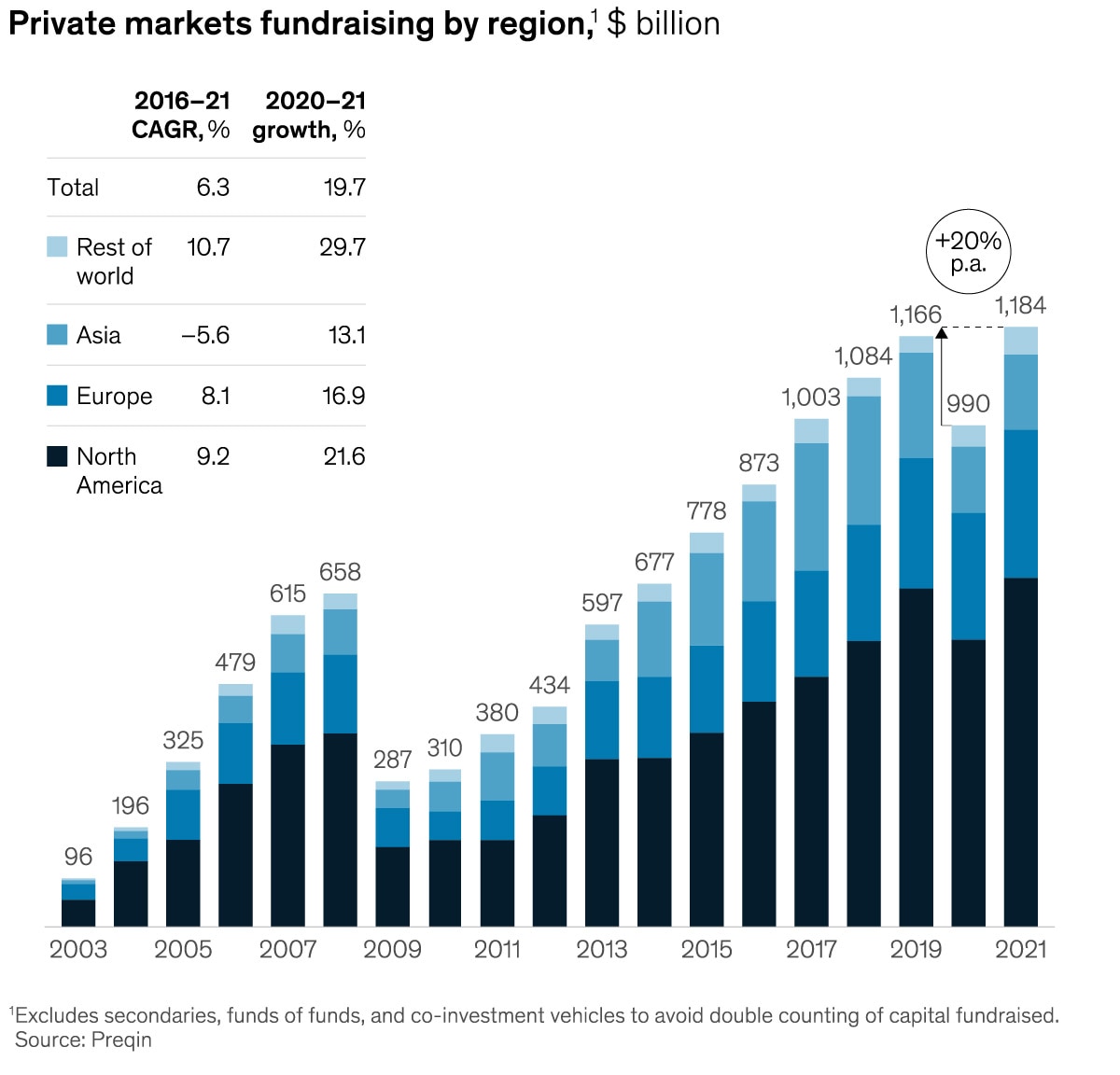| Our best ideas, quick and curated | February 18, 2022
|
| Tech is on our minds this week: women in technical roles, that is, and our latest Tech for Execs installment explains why you need a cloud foundation. Plus, news from the private-equity world—from McKinsey’s latest Global Private Markets Review to an interview with Carlyle’s Sandra Horbach. |
|
|
|
| Wanted: Women in tech. Companies across industries are boosting their efforts to increase the representation of women by focusing primarily on two targets: hiring them into entry-level roles and establishing parity in the C-suite. But our research has found that many organizations are missing the mark at a key moment: equitable advance in early promotion. Across all industries and roles, only 86 women are promoted to manager for every 100 men at the same level. In technical roles—specifically, engineering and product management—just 52 women are promoted to manager for every 100 men. As a result, women are leaving these technical fields in high numbers. |
| Diversity in tech. Diverse teams can help debias the technologies that are ever-present and ever-expanding elements of modern life. Artificial intelligence, for example, has tremendous potential to help humans make fair and impartial choices, but only if the AI systems themselves are not embedded with human and societal biases. One hiring algorithm—at a technology company, no less—was discovered to be penalizing applicants from women’s colleges. Its development was subsequently discontinued, but the example shows how AI can not only bake in bias but also deploy it at scale. Conversely, AI can identify and reduce human bias. And AI systems can be improved to prevent the systems from both reinforcing human and societal biases and creating new ones. Disciplines will need to collaborate on technical improvements, operational practices, and ethical standards to make that happen. |
| Parity. Women earn about half of science and engineering degrees, but they comprise less than 20 percent of the people working in these fields—and the ones who do pursue this career path can often be the only person of their gender in a room. Without a doubt, retaining women in technical roles is crucial for organizations to reach gender parity not just at the top but also throughout the entire workforce. That cannot happen, however, if companies do not retain and advance women in tech roles—and see them as innovators—early in their careers. The task is not simple. It will require management commitment, as well as a systemic approach that includes equitable access to skill building, a structured process that debiases promotions, and a strong culture of support for women. |
| Removing barriers. AI technologies have tremendous potential to contribute to the global economy. For women, automation presents not only myriad opportunities but also new challenges overlaid onto existing ones. McKinsey estimates that between 40 million and 160 million women across the globe may need to transition into higher-skilled roles by 2030, and they will have to be tech-savvy, mobile, and skilled to do so. If they transition successfully, they will need access to better jobs. But women face pervasive barriers that will require concerted and creative new solutions to enable them to move forward in our ever-automated world. |
| — Justine Jablonska |
|
|

|
| OFF THE CHARTS |
| Private markets: Scaling new heights |
| After a year of pandemic-driven turbulence that suppressed fundraising and deal activity, private markets rebounded across the board in 2021. According to McKinsey’s latest Global Private Markets Review, fundraising was up by nearly 20 percent year over year to reach a record of almost $1.2 trillion. Dealmakers were busier than ever, deploying $3.5 trillion across asset classes, and assets under management grew to an all-time high of $9.8 trillion as of July, up from $7.4 trillion a year earlier.
|
|
|
|
|

|
|
|
| INTERVIEW |
| ‘Tenacity and grit’: Building a career in private equity |
| Sandra Horbach, managing director and cohead of US buyout and growth at Carlyle, oversees the private-equity company’s three largest funds, with approximately $60 billion in capital under management. She spoke about the state of private equity at McKinsey’s Women in Private Equity Global Forum, held virtually in late 2021. “Technology has completely reshaped the investment landscape,” Horbach told the gathering. “It’s affecting every part of our business now. And, fortunately, it’s opening the door to a lot more interesting investment opportunities.” |
|
|

|
| MORE ON MCKINSEY.COM |
| Taking stock of the pandemic’s impact on global aviation | McKinsey’s analysis of the aviation value chain in 2020 shows that all subsectors save freight forwarders and cargo airlines suffered huge losses. Although it’s tempting to pin the blame solely on the pandemic-induced plunge in passenger traffic, that would ignore the industry’s underlying and long-term health problems. |
| Lighthouses pave the way for responsible industry transformation | The advanced factories of the Global Lighthouse Network show how sustainability and workforce engagement can accelerate and scale the Fourth Industrial Revolution transformation. |
| Economic development strategies for America’s heartland | There is no one-size-fits-all development strategy for rural communities. Leaders can assess the current state of their region, evaluate existing programs, and establish partnerships as a first step to prioritizing specific initiatives. We looked at how to do that in five community archetypes. |
|

|
|
|
| TECH FOR EXECS |
| Putting your cloud on solid ground |
| Our experts serve up a periodic look at the technology concepts leaders need to understand to help their organizations grow and thrive in the digital age. |
| What it is. If Julius Caesar were a tech engineer, he might describe cloud foundations this way: “All cloud is divided into three parts.” Cloud foundations are the technical underpinnings of any cloud strategy, and they can be broken into three layers: the base, which is the collection of common capabilities that support all the workloads in a business (such as networking or identity management); isolation zones (or “landing zones”), which are the environments where applications live; and application patterns, which are technology solutions that address the most common use cases. |
| Why it’s important. If you build a house without a proper foundation, cracks appear quickly, and it becomes impossible to build up or out. That analogy carries over to cloud. Many companies have favored moving quickly to migrate on-premises applications to the cloud rather than investing in establishing a strong foundation. The problem with this approach is that business struggles to scale after scoring a few quick wins (such as reductions in application and server maintenance costs). For example, adding new applications and capabilities to the cloud and then securing and managing them can become increasingly difficult. As a result, costs mount and progress stalls quickly.
|
| What kinds of problems arise from not having a solid cloud foundation? If you don’t invest in building an architecture with simple, well-designed interfaces between components, adding more capabilities to support new programs becomes challenging (foundation layer 1). If you don’t establish isolation zones to house your applications, issues or changes to one can affect others (foundation layer 2). If you don’t prebuild reusable components for application teams to use when deploying their applications to the cloud, then application teams will need to work with many more people to deploy and secure their applications manually (foundation layer 3). |
| Practically speaking, companies that miss putting in place effective cloud foundations spend ever more resources to get smaller benefits. One company had to hire hundreds of security experts because it hadn’t built a solid automated security architecture into its cloud foundation. Conversely, companies that create a solid cloud foundation can increase cloud migration and adoption speeds by as much as eight times and reduce migration costs by 50 percent over the long term. |
| What to do about it. The good news is that building a cloud foundation does not significantly slow down moving to the cloud nor does it require significant up-front investments. What it does require, however, is knowing what to do and a commitment to unravel some of the shortsighted decisions (for instance, putting all applications in a single isolation zone) that have hampered progress. If your cloud program is having trouble scaling, ask your team what can be done in each of the three layers of the cloud foundation to see if actions there can help fix the issue. |
|
| — Edited by Barbara Tierney |
|
|
Share this Tech For Execs
|

|

|

|
|
|
|
|
| BACKTALK |
| Have feedback or other ideas? We’d love to hear from you. |
|
 |
|
|
|
This email contains information about McKinsey’s research, insights, services, or events. By opening our emails or clicking on links, you agree to our use of cookies and web tracking technology. For more information on how we use and protect your information, please review our privacy policy.
|
|
You received this email because you subscribed to The Shortlist newsletter.
|
|
|
|
Copyright © 2022 | McKinsey & Company, 3 World Trade Center, 175 Greenwich Street, New York, NY 10007
|
|
|
|





